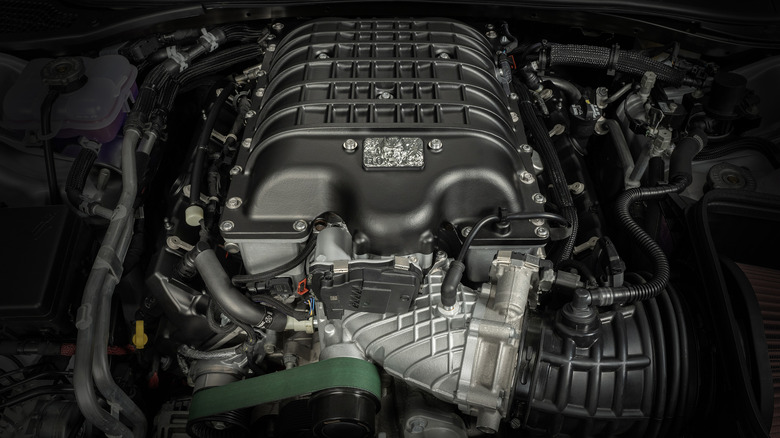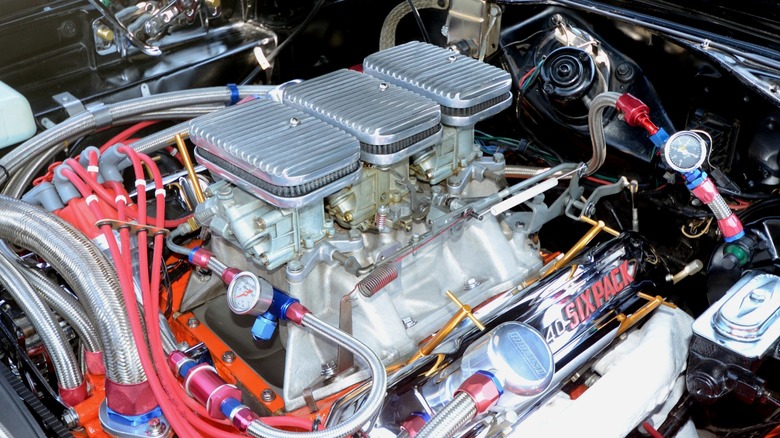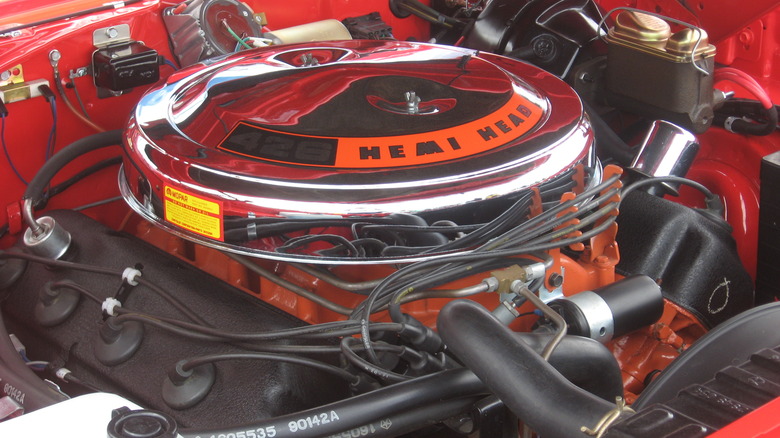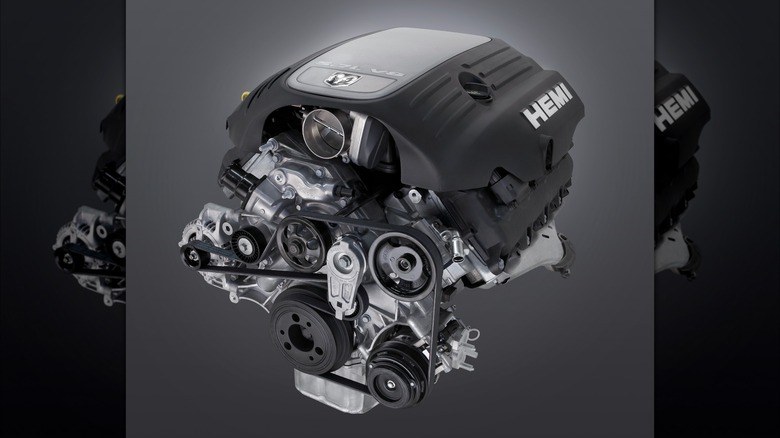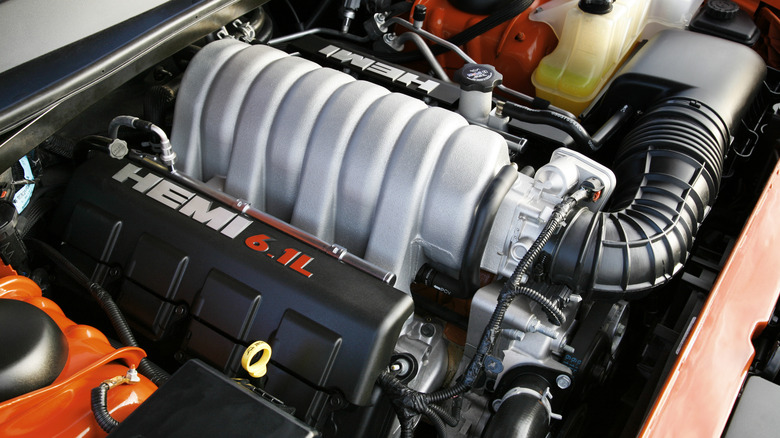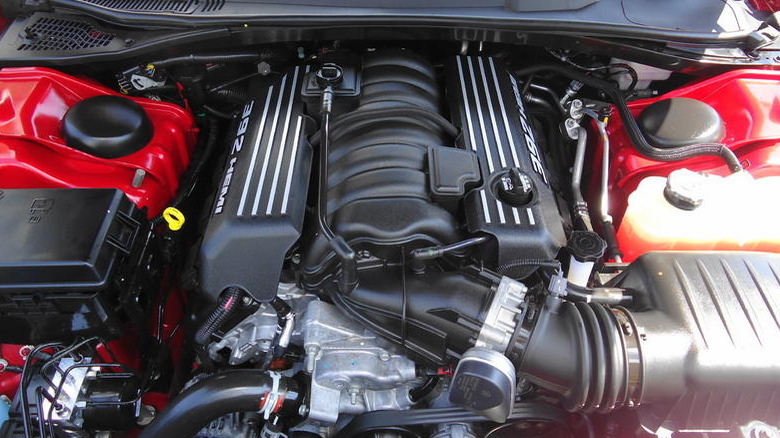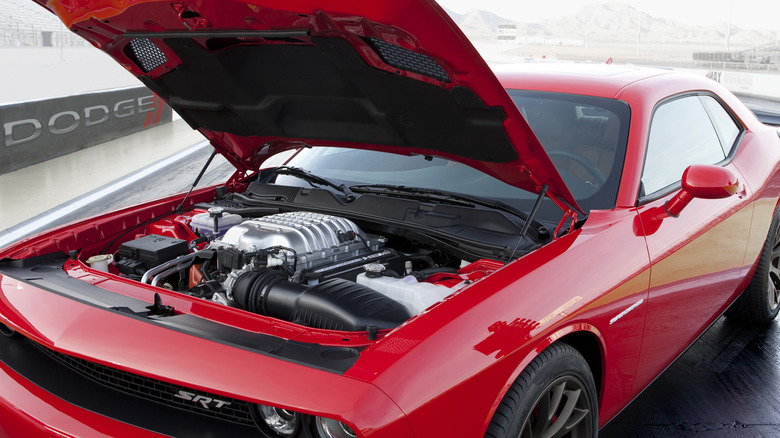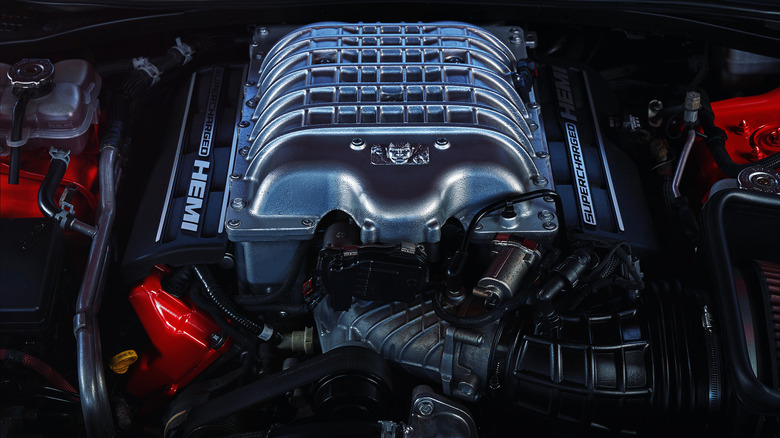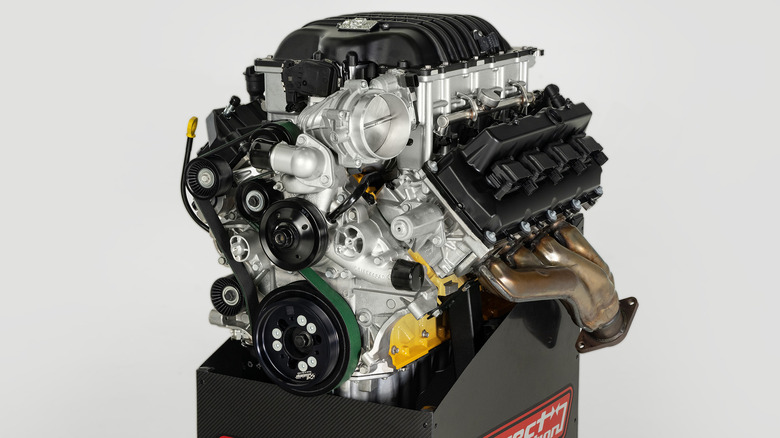8 Most Powerful Engines Put In The Dodge Challenger
After the V8-powered 2023 Dodge Challenger Swinger, the days of burly eight-cylinder engines in Dodge's muscle cars have probably come to an end. The company is going fully electric for the 2024 Charger Daytona, and the V8 Hemi is being dropped for a V6 engine in the gas-powered 2025 Charger Sixpack. And while it's a crying shame, that means there's never been a better time to look back at the Challenger and some of the iconic, high-powered engines that have graced its chassis since Dodge introduced first it in the fall of 1969.
Barring a strange five years (1978-1983) where the Challenger was basically a rebadged Mitsubishi Galant, the Challenger has always been associated with high-powered V8 muscle. From the iconic 426 Hemi and 440 Six Pack engines of the 1970s to the insane supercharged Hemis of the 2010s, Dodge's premier muscle car has played host to a range of impressive — and very powerful — V8s with ever-increasing horsepower and torque numbers over the decades.
So, as we bid farewell to the Challenger and V8 Hemi combo we all know and love, let's take a walk down memory lane and check out some of the highest-horsepower engines Dodge ever installed in the Challenger. They're all V8s, of course — and we wouldn't have it any other way.
440 Six Pack — 390 horsepower
The 440 Six Pack was a high-powered version of the Mopar 440 big-block V8, which debuted in the 1966 Chrysler Imperial with gross numbers of 350 hp and 480 lb-ft of torque. The 440 featured as an option in several other Chrysler cars over the next few years, including Dodge's "Scat Pack" cars like the 1967 Coronet R/T in a slightly hotter guise with 375 hp
But the best would come at the end of the decade: In 1969, Chrysler released the 440 Six Pack, which would power many legendary muscle cars, boasting a triple-carburetor setup with three Holley 2300-series carburetors atop an aluminum Edelbrock intake manifold. The 440 Six Pack featured slightly higher 10.5:1 compression and would receive other upgrades a few months into its life, such as heavy-duty connecting rods. These, in turn, necessitated other new internals, such as updated crankshafts and flywheels.
The result was 390 gross hp and 490 lb-ft of torque, the latter delivered 800 RPM sooner than the 426 Hemi (3,200 RPM versus 4,000 RPM). Chrysler made the 440 Six Pack available in muscle cars like the 1970 and 1971 Dodge Challenger. The 440 and 440 Six-Pack were both options in the Challenger for 1970, but only the 440 Six Pack was available the following year, accompanied by a minor drop to 385 hp.
Dodge built 1,640 440 Six Pack-equipped Challengers in 1970 out of a total of 76,935 units. 1971 was even worse for the 440 Six-Pack Challenger, with only 127 units leaving the factory with a Six Pack and four-speed transmission.
426 Hemi — 425 horsepower
The 426 Hemi is easily one of the best engines ever to grace a Mopar muscle car. Its race-bred big-block heritage and iconic hemispherical heads were an option in a selection of iconic Mopar muscle cars, including the 1970 and 1971 Dodge Challenger.
Chrysler initially designed the 426 Hemi as a competition-only engine, with the goal of competing in NASCAR and NHRA drag racing. It did just that, and arguably did it too well: 426 Hemi-powered cars took the top four spots at the 1964 Daytona 500, prompting NASCAR to stipulate that all engines needed to have a road-going version, which the Hemi didn't have. Enter the Street Hemi.
The Street Hemi retained the race engine's 4.25-inch bore and 3.75-inch stroke but featured several changes for better drivability. These included reduced compression — 10.25:1 vs. 12.5:1 — moderate valve timings, more durable cast iron heads, and more compact exhaust manifolds. Even with these street-focused modifications, the 426 Hemi still made an advertised 425 gross hp and 490 lb-ft of torque, with the real horsepower output likely closer to 500 hp instead.
Chrysler started offering the street-going 426 Hemi as an option in 1966 and continued making it available when the Challenger entered the Mopar family for the 1970 model year. Chrysler built 427 426 Hemi-equipped Challengers over two years before discontinuing the engine in 1972. The Challenger would follow the Hemi into the Mopar graveyard a couple of years later, in 1974.
[Image by Trekphiler via Wikimedia Commons | Cropped and scaled | CC BY 3.0]
5.7-liter Hemi V8 — 375 horsepower
After ending production of the 426 Hemi in 1972, Chrysler wouldn't have a Hemi engine in its stable until 2003, when it reintroduced the Hemi for that year's Ram 1500, 2500, and 3500 trucks. The new 5.7-liter Hemi featured a 3.92-inch bore and 3.58-inch stroke and genuinely hemispherical heads, meaning that the Hemi name was more than just a Chrysler marketing gimmick.
The 5.7-liter Hemi made 345 hp and 375 lb-ft of torque in the Ram trucks, but this would climb when it finally made its way into the rebooted 2009 Dodge Challenger. The Challenger's 5.7-liter Hemi received new features such as variable cam timing, which, alongside higher-flow cylinder heads, increased compression. That, alongside a more aggressive camshaft, helped it make 375 hp and 404 lb-ft of torque when mated to a six-speed manual transmission.
Chrysler also improved the 5.7-liter Hemi's already-present multi-displacement system, which meant that 2009 Challenger owners got all that extra power without sacrificing fuel economy. In fact, Chrysler claimed up to 20% better fuel economy; it still wasn't great at 19 mpg, but that was still better than the 16 mpg the 2003 Ram 1500 managed with the first-generation 5.7-liter Hemi.
Dodge continued to offer the 5.7-liter Hemi V8 in the Challenger up until the end of the line in 2023 without any significant upgrades to the engine.
6.1-liter Hemi V8 — 425 horsepower
Before Chrysler reintroduced the Challenger as a full production model in 2009, the company made a limited run of Dodge Challengers in 2008 that it dubbed the Challenger SRT8. Unlike its production successor, this small run — only 6,400 units built — came with a high-powered 6.1-liter SRT Hemi V8 instead of the 5.7-liter Hemi that would be standard from 2009 onward.
The 6.1-liter Hemi made 425 hp and 420 lb-ft of torque and was developed by SRT engineers, who worked on it alongside the 5.7-liter unit. The engine debuted in 2006 and first saw use in the Chrysler 300C SRT8 and Dodge Magnum SRT8, both of which received the engine in its full, 425-hp guise. The 2006 Jeep Grand Cherokee SRT8 also utilized the 6.1-liter Hemi, albeit with a slightly reduced power output of 420 hp.
SRT engineers made several changes to the 5.7-liter Hemi to bring power up to 425 hp. Boring out the block to 4.06 inches (from 3.92 inches) to increase the displacement undoubtedly helped, but so did a more durable forged steel crankshaft, aluminum exhaust manifolds, and increased valve lift via a more aggressive camshaft profile.
Chrysler produced the 6.1-liter Hemi from 2005 to 2010, after which it introduced a larger 6.4-liter Hemi to replace the 6.1-liter power plant.
6.4-liter Hemi V8 — 485 horsepower
Chrysler's 6.4-liter Hemi was the last non-supercharged Hemi V8 it would introduce, debuting in 2011 as a replacement for the 6.1-liter Hemi V8 for that year's Challenger SRT8 392. The engine also featured in the Charger SRT8 and Jeep Grand Cherokee SRT in 2012, before popping up in the Dodge Durango SRT in 2018.
The 6.4-liter (sometimes labeled the 392) Hemi brought several improvements over its predecessor. A 4.09-inch bore, 3.72-inch stroke engine, it had new port designs and a new hydraulic roller camshaft. It produced 470 hp and 470 lb-ft of torque for most of its early years, climbing to 485 hp and 475 lb-ft of torque in 2015. These better numbers came from a new intake manifold and tweaked engine tuning, coinciding with that year's launch of the Challenger 392 Hemi Scat Pack Shaker.
Chrysler also produced a version of the 6.4-liter Hemi for Medium Duty and Heavy Duty Ram trucks starting in 2015. While the fundamentals are similar, the two versions of the 6.4-liter differ in several aspects, including lower compression, and a different intake manifold tuned for low-torque performance. These changes reduced power to 410 hp and torque to 429 lb-ft — although the truck 6.4-liter V8 reached peak torque slightly quicker than the car version.
The 6.4-liter Hemi V8 was a permanent fixture in the Challenger lineup, powering SRT8 and Scat Pack versions of the car until the final 2023 model year.
[Image by Ammar shaker via Wikimedia Commons | Cropped and scaled | CC BY-SA 3.0]
6.2-liter Hellcat V8 — 717 horsepower
The 6.2-liter supercharged Dodge Hellcat V8 engine was neither the first nor the largest Hemi to make its way into the revived Challenger — those honors go to the 5.7-liter Hemi in 2009 and the 6.4-liter unit from 2011, respectively. However, its 707 hp and 650 lb-ft of torque set records when it debuted in the 2015 Dodge Challenger SRT, being the most powerful V8 the company had ever produced up until then.
The Hellcat V8 combined the 6.4-liter Hemi's 4.09-inch bore with the 3.58-inch stroke of the 5.7-liter Hemi V8, while also reusing the cylinder heads and block from the former — albeit with some modifications for improved cooling. But the 6.2 Hellcat wasn't just a parts-bin special Dodge cobbled together: Most of the engine was all-new, including the twin-screw supercharger, which displaced 2.3 liters and ran at 11.6 pounds of boost.
707 hp was enough for Chrysler to claim that the 2015 Challenger SRT was the most powerful muscle car ever, at least as far as factory cars were concerned. But the company didn't stop there, increasing power slightly to 717 hp and 656 lb-ft of torque for the 2019 model year, by which point the car was known as the Dodge Challenger SRT Hellcat.
The 6.2-liter Hellcat V8 never left the Dodge lineup after its introduction in 2015 and was available in its 717-hp guise up until the end of the V8-powered Challenger in 2023.
6.2-liter Demon V8 — 840/807/797 horsepower
The Demon V8 was a modified Hellcat engine that was the beating heart of the 2018-only Dodge Challenger SRT Demon. The Demon produced 840 hp and 770 lb-ft of torque running on 100-octane fuel, a 120-odd hp increase over the Hellcat.
SRT engineers made several changes to the Hellcat V8 to extract all that power, including a larger 2.7-liter supercharger running at 14.5 pounds of boost. The Demon V8 also revved higher — 6,500 RPM — and had a liquid-to-air intercooler system, along with upgrades to critical areas such as the valvetrain, crankshaft, and engine block.
But while the Challenger SRT Demon only existed for a year, the Demon V8 would return in 2019, in slightly neutered form, for the Dodge Challenger Hellcat Redeye. The 2019 Hellcat Redeye's Demon V8 put out 797 hp and 707 lb-ft of torque due to a more restrictive intake and use of the Demon's lower-power pump gasoline tune.
But Dodge wasn't done with the Demon engine, oh no. The final version of the Demon V8 powered 2022's Challenger SRT Super Stock, and made 807 hp. The Super Stock's engine was identical to that of the Hellcat Redeye, with the only difference being a higher shift point on the Super Stock version — 6,400 RPM versus the Redeye's 6,300 RPM, leading to the extra 10 hp. Both versions would continue into the 2023 model year before Dodge ended production of Hemi-powered Challengers at the end of the year.
6.2-liter Demon 170 V8 — 1,025 horsepower
Finally, we come to the latest and greatest iteration of the Hemi V8 Chrysler has ever made — and will likely ever make, as it's saying goodbye to Hemi engines starting in 2024. The Demon 170 engine powering the Dodge Challenger SRT Demon 170 was the first production Hemi to make more than 1,000 horsepower, with a staggering 1,025 hp and 945 lb-ft of torque — on E85 ethanol fuel — coming from its supercharged Hemi V8.
The Demon 170's Hellephant C170 V8 Engine was a further modified Demon V8, with a larger 3.0-liter supercharger and 105-mm throttle body that produced 21.3 pounds of boost. This was 40% more boost than the supercharger on the Hellcat Redeye and enough for the engine to still outperform the Demon V8 on standard 91-octane pump gasoline. Owners who filled up at the pumps could expect 900 hp and 810 lb-ft of torque
Dodge built 3,300 Challenger SRT Demon 170s, capping off its Last Call series of 2023 cars with a huge bang. However, while the car may have been a one-time offer, the engine looks like it'll stay around for quite a while longer, at least in crate engine form. An October 2023 press release announced that the Hellephant C170 engine would be available from Direct Connection. Great news for V8 fans, although the $27,695 price means it'll only be for the well-heeled Mopar fanatic — or anyone who really wants to own one of the most powerful Dodge crate engines ever built and doesn't mind paying a steep price for the privilege.
